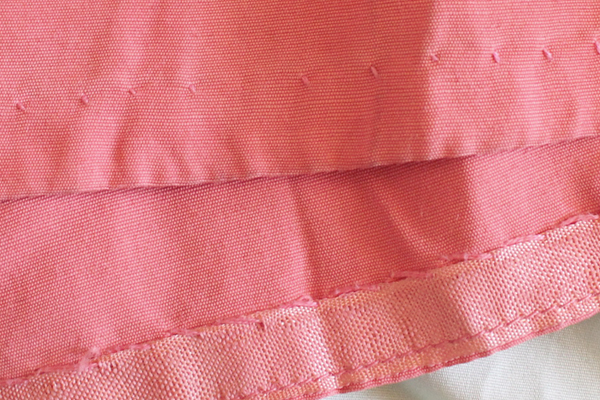Vintage sewing techniques really aren’t all that different from modern ones when it comes down to it, but when re-creating vintage garments, it’s the small details that make all the difference. You could easily sit down with a vintage dress or pattern, compare them to their modern counterparts, and get lost in the all the similarities and differences in the various sewing techniques used for each. That’s rather fun to do sometimes actually, and I did just that when taking photos for this very post.
Here are three vintage sewing techniques that I think are the most recognizably different when compared to modern sewing.

Zippers
Most of the vintage dresses I’ve seen have metal zippers that are either centered or lapped. I’ve read mixed reviews in my research as to when the invisible zipper was popularized, but it seems the late ’60s is the era when the invisible zipper hit the home sewing market.
With garment sewing today, the invisible zip tends to dominate as far as suggested notions go, especially with tailored dresses and skirts. Centered zippers are still popular of course, but I see far less lapped zippers in commercial patterns.
When installed neatly, the lapped zipper has a very professional appearance and definitely adds a vintage flare to any dress. I wouldn’t say there’s one zipper that’s better or more convenient than all the rest because it really comes down to practice and personal preference. Learn how to sew one of each in the FREE Bluprint class Mastering Zipper Techniques and see which one you like the best. The lapped zipper is my personal favorite.

Hand sewing
Another classically vintage sewing technique is the presence of hand-sewn finishing. You’ll find all sorts of special presser feet nowadays to help make hemming faster and easier, and there’s definitely an advantage to machine finishing in many ways. The blind hem foot and rolled hem foot are just two examples of modern machine accessories that make our lives a little easier in the sewing room, but there’s something to be said for hand-stitching as well.
Sewers who are proficient in hand-sewing can blind hem a skirt or a facing that’s arguably stronger and more invisible than what a machine can do. Hand-sewn details make for a beautiful, or even couture looking finish. It really can make a big difference in your garment to not have a line of machine stitching running along the hem or neckline, especially when sewing something for a special occasion.

Photos via Lucky Lucille
Seam finishing
Using pinking shears to finish the raw edges of your handmade clothes is nothing out of the ordinary. It’s easy, it’s fast, and it’s an inexpensive investment to make as far as seam finishes go.
We tend to think of pinked seams as a telltale sign of handmade clothing, so it’s a little surprising to see it used on 1950s department store dresses! Machine seam finishing techniques and sergers existed before the ’50s, but it’s more common than you might think to see higher end ready-made clothing with pinked seams, or even raw seams.
Serged seams are without a doubt the seam finishing technique of choice today and many sewers favor them for the professional touch they add to garments made at home. You shouldn’t feel embarrassed or cheapened by pinked seams at home though, because clearly they’re good enough for vintage brands like Suzy Perette!
The 1950s cocktail dress shown in the photo above has pinked seams throughout the dress, as well as a centered back zipper, and hand-stitched hems and facings. So you can see how all of these little details come together to make a garment more “vintage” when compared to a modern dress of a similar style. If you’re looking to create a dress like this at home and want to add that authentic vintage touch to your handmade garments, sign up for Sewing Vintage: The Flirty Day Dress with Laura Nash.

My mother always sewed hems my hand. It is true, you cannot see the stitches on the right side. So glad she taught me this skill!